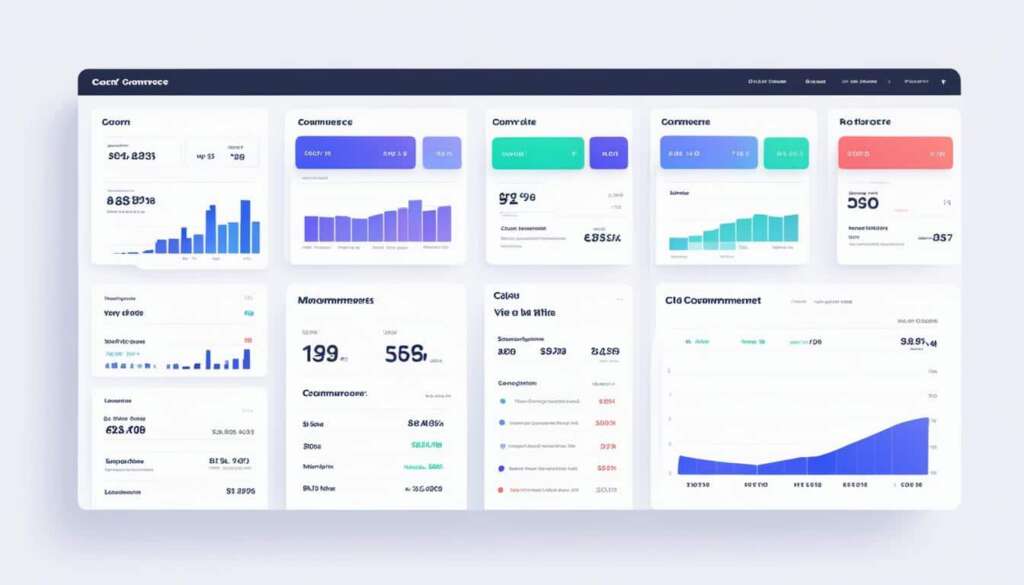Table of Contents
Measuring online business performance is crucial for driving growth in the dynamic landscape of digital retail. E-commerce metrics provide valuable insights into the health and success of an online shopping business, allowing companies to make data-driven decisions and optimize their strategies. By tracking and analyzing these metrics, businesses can identify areas for improvement, capitalize on opportunities, and stay ahead of the competition.
In this article, we will explore the importance of e-commerce metrics in understanding online business performance. We will delve into the top metrics that businesses should track for success, including website metrics, conversion metrics, customer metrics, inventory and ROI metrics, and mobile and traffic metrics. By leveraging these metrics, businesses can optimize their online presence, enhance customer experiences, and unlock their full potential.
How to Measure Ecommerce Success
Measuring ecommerce success involves tracking and analyzing various ecommerce metrics. To accurately assess the performance of an online business, it is crucial to set measurable and achievable goals based on the data provided by these metrics. By monitoring these key performance indicators (KPIs), businesses can make data-driven decisions and continuously improve their strategies for optimal results.
Here are the top 15 ecommerce performance metrics that should be tracked to measure success:
- Sessions by traffic source
- Sessions by device
- Sessions by location
- Click-through rate (CTR)
- Bounce rate
- Conversion rate
- Cart abandonment rate
- Average order value
- Cost per acquisition (CPA)
- Customer lifetime value (CLTV)
- Return on investment (ROI)
- Customer satisfaction rate
- Repeat purchase rate
- Website traffic sources
- Social media engagement
These ecommerce metrics provide valuable insights into visitor behavior, traffic sources, user experience, and customer satisfaction. By analyzing and interpreting the data from these metrics, businesses can identify areas for improvement, optimize marketing strategies, and enhance overall ecommerce performance.
Setting Accurate and Achievable Goals
When measuring ecommerce success, it is essential to set goals that are specific, measurable, achievable, relevant, and time-bound (SMART goals). By establishing clear objectives for each metric, businesses can track their progress and make necessary adjustments to achieve optimal results.
Tracking ecommerce metrics helps businesses understand how their strategies are performing and guides them in making data-driven decisions for continuous improvement.
Whether the objective is to increase website traffic, improve conversion rates, or enhance customer satisfaction, setting accurate goals based on ecommerce metrics provides a benchmark for success and enables businesses to track their progress effectively.
By consistently tracking and analyzing ecommerce metrics, businesses can gain valuable insights into their online performance, make informed decisions, and drive sustainable growth.
Website Metrics for Ecommerce Success
When it comes to running a successful ecommerce business, tracking the performance of your website is crucial. Website metrics provide valuable insights into various aspects of your site, helping you make informed decisions and optimize your online presence. By effectively measuring and analyzing these metrics, you can drive more ecommerce traffic, enhance user experience, and ultimately boost your online sales.
Tracking Ecommerce Traffic
Sessions by Traffic Source: One important website metric to monitor is the sessions by traffic source. This metric allows you to identify the sources of your website traffic, whether it’s organic search, paid advertisements, social media, or direct traffic. By tracking which channels are driving the most visitors to your site, you can allocate resources and optimize your marketing efforts accordingly.
Enhancing User Experience
Sessions by Device: Understanding the devices your visitors are using is vital for delivering a seamless user experience. Sessions by device provides insights into whether your website is predominantly accessed through desktop computers, mobile devices, or tablets. By prioritizing the user experience for specific devices, you can ensure that your site is optimized for all screen sizes and improve overall customer satisfaction.
Personalizing Communication
Sessions by Location: Tailoring your communication based on the geographical distribution of your website visitors can be highly effective. Sessions by location metric allows you to understand where your audience is coming from, enabling you to create targeted campaigns, localize content, and cater to specific regional preferences.
Measuring Content Effectiveness
Click-through Rate (CTR) and Bounce Rate: CTR and bounce rate metrics provide valuable insights into the effectiveness of your website content and user engagement. A high CTR indicates that your content is compelling and driving visitors to explore further, while a high bounce rate may indicate issues with page relevance or user experience. By analyzing these metrics, you can optimize your content strategy, improve click-through rates, and reduce bounce rates.
By regularly monitoring and analyzing website metrics, ecommerce businesses can track website performance, identify areas for improvement, and refine their strategies. The data provided by these metrics can guide decision-making, ensuring that you are delivering the best possible user experience and driving ecommerce success.
Conversion Metrics for Ecommerce Success
Conversion metrics are essential for evaluating the success of your ecommerce business. By tracking key metrics such as sales conversion rate, product return rate, and shopping cart abandonment rate, you can gain valuable insights into your customers’ behavior, identify potential areas for improvement, and optimize your overall ecommerce strategy.
Sales Conversion Rate
The sales conversion rate measures the percentage of website visitors who make a purchase. A high conversion rate indicates that your website and products are appealing to your target customers, while a low conversion rate may suggest room for improvement. By tracking this metric, you can identify which products or pages are performing well and leverage that information to drive further growth.
Product Return Rate
The product return rate measures the number of returned items and the reasons for returns. This metric provides valuable insights into product quality, customer satisfaction, and potential areas for improvement. By understanding why customers are returning products, you can make necessary adjustments to product information, improve the accuracy of product descriptions, and refine your return policies to enhance the overall shopping experience.
Shopping Cart Abandonment Rate
The shopping cart abandonment rate indicates the percentage of visitors who add products to their shopping cart but do not complete the checkout process. A high abandonment rate may suggest potential issues in the checkout process or user experience, such as complicated navigation, lengthy forms, or unexpected costs. By analyzing and addressing the factors contributing to cart abandonment, you can optimize the checkout process and improve conversion rates.
“Understanding and optimizing conversion metrics is crucial for driving growth in your ecommerce business. By tracking the sales conversion rate, product return rate, and shopping cart abandonment rate, you can identify areas for improvement and make data-driven decisions to enhance the overall shopping experience.”

Tracking and analyzing conversion metrics is key to unlocking the full potential of your ecommerce business. By continuously monitoring these metrics and implementing strategies to improve your sales conversion rate, reduce product return rate, and minimize shopping cart abandonment, you can drive growth, increase customer satisfaction, and achieve ecommerce success.
Customer Metrics for Ecommerce Success
Tracking customer metrics is crucial for achieving success in ecommerce. By understanding and improving customer relationships, businesses can drive growth and increase profitability. In this section, we will explore three key customer metrics: customer retention rate, customer satisfaction, and cost per acquisition.
Customer Retention Rate
Customer retention rate measures the percentage of customers who return to make repeat purchases. It is a valuable metric for assessing customer loyalty and satisfaction. A high retention rate indicates that customers are satisfied with the products, services, and overall experience provided by the ecommerce business. By focusing on customer retention, businesses can build long-term relationships, increase customer lifetime value, and reduce the need for costly customer acquisition efforts.
Customer Satisfaction
Customer satisfaction metrics provide insights into the quality of customer experiences. These metrics can include customer feedback, reviews, ratings, and surveys. By measuring customer satisfaction, ecommerce businesses can identify areas for improvement and address any issues or pain points that may be impacting the customer experience. By consistently delivering excellent customer service and addressing customer needs, businesses can enhance customer satisfaction levels and foster loyalty.
Cost per Acquisition (CPA)
Cost per acquisition (CPA) measures the average cost of acquiring a new customer. This metric is essential for evaluating the effectiveness and efficiency of marketing and advertising efforts. By tracking the CPA, businesses can gauge the return on investment for their customer acquisition strategies. A lower CPA indicates that an ecommerce business is acquiring customers at a lower cost, maximizing the value of each customer acquired, and optimizing marketing spend.
“Understanding and leveraging customer metrics is vital for ecommerce success. Measuring customer retention rate, customer satisfaction, and cost per acquisition provides valuable insights into customer loyalty, overall experience, and the efficiency of marketing efforts.”
<!–
–>
| Metric | Definition |
|---|---|
| Customer Retention Rate | The percentage of customers who return to make repeat purchases |
| Customer Satisfaction | Measurements of customer feedback, reviews, ratings, and surveys to assess satisfaction levels |
| Cost per Acquisition (CPA) | The average cost of acquiring a new customer |
By prioritizing customer-centric strategies and delivering exceptional customer service, ecommerce businesses can improve customer retention, satisfaction, and the overall success of their online operations.
Inventory and ROI Metrics for Ecommerce Success
Efficient inventory management is crucial for the overall profitability of an ecommerce business. By tracking inventory and return on investment (ROI) metrics, businesses can optimize their inventory management and make data-driven decisions for growth and success.
Inventory Turnover Rate: Optimizing Inventory Levels
The inventory turnover rate measures how quickly products are sold within a given period. It is calculated by dividing the cost of goods sold (COGS) by the average inventory value.
By closely monitoring the inventory turnover rate, ecommerce businesses can optimize their inventory levels and avoid the costly pitfalls of overstocking or understocking. Maintaining an optimal inventory level ensures that products are available when customers demand them, reducing holding costs and increasing customer satisfaction.
Return on Investment (ROI): Evaluating Marketing Campaigns and Investments
Return on investment (ROI) is a critical metric for evaluating the profitability of marketing campaigns and other investments. It measures the return generated from a specific investment relative to its cost.
By analyzing ROI, ecommerce businesses can make informed decisions about resource allocation and prioritize investments that yield the highest returns. This metric enables business owners to identify the most profitable marketing channels, optimize advertising spend, and drive revenue growth.
Here is an example of how ROI is calculated:
| Investment | Cost | Return | ROI |
|---|---|---|---|
| Marketing Campaign A | £10,000 | £15,000 | 50% |
| Marketing Campaign B | £5,000 | £7,500 | 50% |
| Marketing Campaign C | £7,000 | £10,000 | 43% |
By evaluating the ROI of different marketing campaigns, ecommerce businesses can allocate their resources more effectively to maximize profitability.

Optimizing inventory management and monitoring ROI metrics empower ecommerce businesses to make data-driven decisions that drive growth and profitability.
Mobile and Traffic Metrics for Ecommerce Success
In today’s digital world, mobile devices have become an integral part of online shopping. As more and more consumers use their smartphones and tablets to make purchases, it is crucial for ecommerce businesses to focus on mobile optimization and user experience. To measure the effectiveness of mobile strategies, the mobile conversion rate is a key metric to consider.
Mobile conversion rate measures the percentage of mobile users who make a purchase on an ecommerce website. It provides valuable insights into the performance of the mobile user interface, checkout process, and overall customer experience. By monitoring and improving the mobile conversion rate, businesses can capitalize on the growing mobile market and increase sales.
However, mobile optimization shouldn’t be the only aspect to consider. Understanding website traffic is equally important for ecommerce success. By analyzing website traffic metrics, businesses can gain valuable insights into the popularity and reach of their online store.
Website traffic metrics such as total visits, unique visitors, and page views provide a comprehensive view of the website’s performance. These metrics help ecommerce businesses evaluate the effectiveness of their marketing efforts, identify traffic sources, and assess user engagement.
Examples of Website Traffic Metrics:
| Traffic Metric | Description |
|---|---|
| Total Visits | The total number of visits to the website, including both new and returning visitors. |
| Unique Visitors | The number of individual visitors to the website within a specific time period, regardless of the number of visits made by each visitor. |
| Page Views | The total number of pages viewed by visitors on the website. |
By combining mobile optimization efforts with an analysis of website traffic, ecommerce businesses can ensure targeted traffic to their online stores. By analyzing demographic information and behavioral data, businesses can optimize their marketing strategies to attract the right audience and improve overall website performance.
Effective mobile optimization and targeted traffic strategies can significantly impact the success of an ecommerce business. By focusing on improving the mobile conversion rate and analyzing website traffic metrics, businesses can maximize their reach, increase sales, and enhance the overall customer experience.
By prioritizing mobile and traffic metrics, ecommerce businesses can position themselves for success in the ever-evolving digital landscape. Continual tracking and analysis of these metrics enable businesses to make data-driven decisions, adapt to changing consumer behaviors, and stay ahead of the competition.
Conclusion
Measuring and analyzing ecommerce metrics is essential for achieving success in the competitive world of online retail. Key Performance Indicators (KPIs) provide valuable insights into the health and performance of an ecommerce business, enabling data-driven decisions that can drive growth and optimize strategies. By diligently tracking metrics such as conversion rate, average order value, customer lifetime value, and customer satisfaction, ecommerce businesses can make data-driven decisions to improve their online retail operations.
Successful ecommerce businesses understand the importance of prioritizing the measurement and utilization of these metrics to achieve their desired outcomes. By optimizing strategies based on ecommerce KPIs, businesses can improve customer experiences, increase profitability, and unlock their full potential in the online retail space. Regular monitoring and adjustment of ecommerce metrics ensure that businesses stay ahead in the dynamic ecommerce landscape and consistently adapt to changing market demands.
For ecommerce businesses striving for success, leveraging data-driven decisions backed by ecommerce KPIs is the key. By embracing a culture of constant measurement and analysis, businesses can make informed decisions, optimize their operations, and ensure ecommerce success.
FAQ
What are e-commerce metrics?
E-commerce metrics are data points that measure and analyze the performance of an online shopping business. They provide insights into sales improvement, most and least purchased items, opportunities for increasing sales, and performance on key performance indicators (KPIs).
Why are e-commerce metrics important?
E-commerce metrics are important because they help businesses determine which strategies are working and how to improve the ones that aren’t. Companies that frequently use e-commerce performance analytics are more likely to outperform their competitors in profit, sales, sales growth, and return on investment (ROI).
How do I measure e-commerce success?
Measuring e-commerce success involves tracking and analyzing various e-commerce metrics. It is important to set accurate and achievable goals based on the data provided by these metrics.
What website metrics should I track for e-commerce success?
Website metrics such as sessions by traffic source, sessions by device, sessions by location, click-through rate (CTR), and bounce rate should be tracked for e-commerce success. These metrics provide valuable information on visitor behavior, traffic sources, and user experience, which can help improve overall e-commerce performance.
What conversion metrics are important for evaluating e-commerce success?
Conversion metrics such as sales conversion rate, top products by units sold, shopping cart abandonment rate, and product return rate are important for evaluating e-commerce success. These metrics provide insights into the appeal of the website and products, as well as potential issues in the checkout process and user experience.
Why are customer metrics important in e-commerce?
Customer metrics are important in e-commerce because they help businesses understand and improve customer relationships. Metrics such as customer retention rate, customer satisfaction, and cost per acquisition provide insights into customer loyalty, satisfaction, and the efficiency of marketing and advertising efforts.
How do inventory and ROI metrics impact e-commerce success?
Inventory and ROI metrics are crucial for efficient inventory management and overall profitability in e-commerce. Metrics such as inventory turnover rate and return on investment help optimize inventory levels, reduce holding costs, and guide resource allocation and prioritization.
What mobile and traffic metrics should I track for e-commerce success?
Mobile and traffic metrics such as mobile conversion rate, website traffic (total visits, unique visitors, and page views), and demographic and behavioral data should be tracked for e-commerce success. These metrics help optimize mobile optimization, user experience, and marketing strategies for targeted traffic.
Why is measuring and analyzing e-commerce metrics important?
Measuring and analyzing e-commerce metrics is essential for success in the competitive world of online retail. Key performance indicators (KPIs) provide valuable insights into the health and performance of an e-commerce business and guide data-driven decisions. Regularly monitoring and adjusting these metrics is the key to staying ahead in the dynamic e-commerce landscape.







